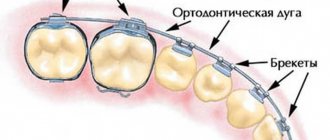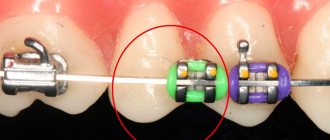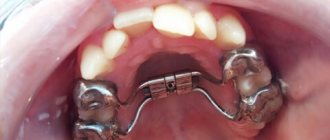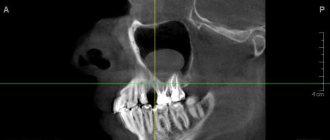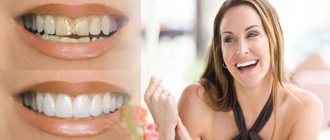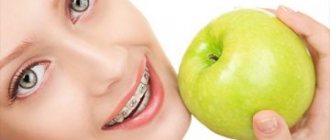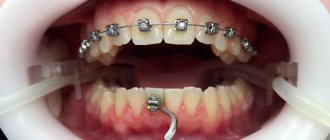Problem: parents contacted a 12-year-old boy. The child's fang is protruding on one side.
Solution: treatment was performed with the Damon brace system. The canine was put in place, the bite was corrected.
Orthodontist consultation
At the consultation, the parents said that previously the fangs had protruded on both sides, but treatment with an orthodontic plate at the local orthodontist put one fang in place, but the second could not be put in place. The treatment with braces with tooth extraction on one side proposed at the district clinic did not appeal to the parents, and they came to the orthodontist at Dial-Dent.
The consultation revealed an incorrect position of the canine, crowded teeth, and incorrect inclination of the front teeth. The distant chewing teeth, the so-called “sevens,” have not yet erupted, so now is the best time to start orthodontic treatment - there is potential for jaw growth, and the treatment will be easier for the child, and the result will be more stable.
The orthodontist spoke about the possibilities of orthodontic treatment, different brace systems and their features, approximate cost and timing. It usually takes about 1.5-2 years to achieve a stable result. No tooth extraction will be required, as modern braces successfully solve problems such as lack of space.
Since the teenager and his parents were serious about orthodontic treatment with braces, the boy was sent for in-depth diagnostics: photometry, OPTG, TRG in the lateral projection, taking impressions of the dentition. A consultation with an osteopath and speech therapist is also recommended, since malocclusion is interconnected both with the position of the head and posture, as well as with the position of the tongue and the correct development of the facial muscles.
Photometry before orthodontic treatment:
Panoramic photo of teeth before treatment:
TRG in lateral projection:
Speech therapist consultation
Speech therapist Tsukor T.B. revealed incorrect position of the tongue, weakness of the tongue muscles, and infantile type of swallowing. A set of exercises for practicing at home is given.
Osteopath consultation
Osteopath An T.Z. Conducted osteopathic diagnostics. Since osteopathic disorders are of a descending type, that is, changes are caused by malocclusion, osteopathic correction is planned throughout the entire orthodontic treatment to adapt the body to the new position of the jaw.
The orthodontist combined the results of research and consultations, made calculations and drew up a treatment plan.
Of the external or internal braces proposed for treatment, the Damon braces system was chosen. To make the teenager less embarrassed about braces, Damon Clear ceramic braces will be installed on the upper teeth, which are almost invisible on the teeth. Metal braces will be installed on the lower teeth, since when communicating, the lower teeth are covered with the lip, and the braces do not attract attention.
Preparing for treatment
A panoramic photograph of the teeth was taken, an X-ray of the skull in a lateral projection (TRG-lateral), and impressions of the teeth were taken. The teenager underwent consultation with an osteopath, speech therapist, and pediatric dentist. Photometry was taken - the face and teeth from different angles.
Initial situation:
At a consultation with an osteopath , the osteopath did not identify any significant problems regarding the musculoskeletal system that could affect the bite. A small correction is proposed after each visit to the orthodontist in order to compensate for the influence of orthodontic equipment - to relieve tension in the bones of the skull, temporal joints, and neck.
At a consultation with a speech therapist , the condition of the muscles of the lips and tongue was tested. A decrease in tongue muscle tone and improper swallowing were revealed. A list of exercises is given that you can perform independently to train the muscles of the tongue and neck.
A consultation with a pediatric dentist revealed caries on one of the teeth, which must be cured before orthodontic treatment .
Consultations with specialists are provided free of charge. A feature of the treatment at Olga Baranova’s ORTHODONT PROJECT is an integrated approach to treatment - the interaction of different specialists aimed at eliminating all negative factors that disrupt the position of the teeth, which gives more stable results of orthodontic treatment .
The results of all consultations and examinations were sent to the orthodontist . The doctor carried out the necessary calculations, and on the second visit she explained the treatment plan, and also offered several braces to choose from.
The Damon self-ligating bracket system was chosen. In this bracket system, the braces are small in size with rounded edges. braces on the upper front teeth , which are less noticeable to others. It is better to use Damon Q metal braces to protect the upper teeth from excessive wear. When smiling and talking, the lower teeth are covered by the lip, and the aesthetics are not greatly affected.
After the brace system was approved, a treatment contract was signed and the cost of the brace system was paid. Payment for treatment can be made in full or in stages - half when fixing braces
and the balance in equal parts at each visit.
To maintain the health of the teeth while wearing braces, before fixing the braces as a gift, hygienic preparation of the teeth , including removing plaque using the Air Flow method, removing tartar with ultrasound, and polishing the surface of all teeth. The hygienist explained on a model the rules for brushing teeth with braces with a special orthodontic brush, showed how to use dental brushes, a single-tuft brush and special dental floss to clean braces and interdental spaces.
The next step will be fixing the braces , which is the beginning of orthodontic treatment.
Start of orthodontic treatment
Before installing braces on the teeth, a professional teeth cleaning was carried out, as a result of which old plaque was removed, the teeth were polished so that the plaque sticks less, and training was provided in brushing teeth with braces.
Braces are installed on the teeth in two stages for gradual adaptation to new sensations. A starter hygiene kit was issued, which contains everything necessary for caring for teeth with braces, and explains in detail what is intended for what. The starter kit includes orthodontic wax, orthodontic toothbrush, toothpaste, brushes, dental floss, and monobrush. The set was prepared by specialists and is given as a gift when fixing braces.
Damon braces on teeth:
The first arches, which are installed at the beginning of treatment, are made of material that has a memory effect. The doctor bends the arch according to the shape of the dentition, and the arch strives to acquire the original correct shape, thereby changing the position of the teeth. The Damon brace system exerts weak forces on the teeth, but the impact is constant. This combination of constant pressure and gentle forces produces the most consistent orthodontic treatment results.
Features of the period.
By the age of 9, the child’s upper and lower incisors and first permanent molars erupt in the child’s dentition. The dentition still contains primary canines and molars. The permanent incisors are normally positioned evenly in the dentition without “protrusion” or “sagging” to the side.
By the age of 10, the process of formation of the roots of permanent teeth that have already erupted in the oral cavity (first molar, central and lateral incisors) is completed. These teeth are “stabilized” in the bone tissue.
At 9–10 years of age, the roots of the 4th milk tooth (1st primary molar) are reabsorbed and replaced with the 4th permanent tooth (1st premolar) first on the upper and then on the lower jaw. From 10 to 12 years of age, the roots of the 5th primary tooth (2nd primary molar) and primary canine begin to be reabsorbed and replaced by the 2nd premolar and permanent canine, respectively. The permanent canine is the last one to erupt.
By the age of 12–13 years, the replacement of baby teeth with permanent teeth is completed. There should be 24 teeth in the dentition: 12 on each jaw.
The child is 9 years old: his upper and lower permanent central and lateral incisors and first molars have erupted. The milk chewing teeth and fangs are still motionless, although the resorption of their roots has already begun.
Orthodontic treatment with braces
Visits to the orthodontist took place every 1.5-2 months. Each time, the orthodontist pays attention to hygiene, monitors the progress of treatment, carries out the manipulations outlined in the treatment plan - changes the arches, adds the necessary elements to the brace system.
The protruding fang fell into place a month after the start of treatment. But the treatment ends only when a stable correct position of all teeth has been achieved and physiological interdental contacts have been created.
While wearing braces, in addition to brushing your teeth twice a day, it is recommended to have your teeth professionally cleaned every six months. This will help remove plaque accumulation in hard-to-reach places (around braces and gums, under arches). Long-term accumulation of plaque leads to demineralization of the enamel and the appearance of white spots on the teeth, which become very noticeable after the braces are removed.
Before brushing your teeth with Air Flow:
After professional teeth cleaning with Air Flow:
To correct the bite, you need to wear orthodontic elastics - elastic rings of different lengths, which are attached to special hooks on braces or arches. The child must secure the oroelastics himself, changing them daily. The orthodontist shows how the elastics are secured and checks whether the patient has understood everything correctly.
It is better for parents to monitor this process, since the duration and result of orthodontic treatment depends on the correct wearing of elastics. You should always have spare elastics with you, since breaks in wearing are extremely undesirable, and if one elastic breaks, both must be changed so that the traction is symmetrical.
After 1 year and 1 month:
Clinic doctors
To enable chewing teeth to perform their function, they have cusps and depressions in the tooth enamel (fissures). These formations form the relief necessary for grinding food. The depth of the grooves is approximately two and a half to three millimeters, but over time they become larger.
Types of fissures on the surface of teeth
Depending on the anatomical structure, there are four types of depressions on the enamel of teeth:
- Funnel-shaped.
Compared to other species, they are more open and, thanks to the access of saliva, are better mineralized. The shape itself with a rounded bottom helps wash away food debris.
- Cone-shaped.
The level of mineralization is lower and the likelihood of food particles accumulating is higher, so it is important to carefully monitor the quality of cleaning.
- Teardrop-shaped.
Such depressions on the chewing surface of the teeth are characterized by a narrow entrance and a wide bottom, which is why they are poorly mineralized and inaccessible for cleaning.
- Polypoid.
Their features are similar to teardrop-shaped cavities, but have an elongated shape.
Carious lesions in the grooves of tooth enamel
Since the grooves and grooves on the teeth present difficulties for hygiene, plaque accumulates there. And this is an excellent breeding ground for pathogenic bacteria. Microbes cause the appearance of carious cavities on the tooth enamel.
This type of caries is called fissure caries. It is not easy to recognize, especially at an early stage. Pronounced dark spots appear when the process is quite advanced. As the disease progresses, the lower layers of tissue are destroyed. Then another sign appears: the depressions on the tooth enamel and in the dentin layer become sensitive to the effects of cold, hot and sweet.
Treatment of depressions in tooth enamel
As long as the enamel is not seriously damaged, the process can be stopped with the help of fluoride and calcium-containing preparations, as well as sealants. In more complex cases, treatment of depressions in tooth enamel and dentin requires preparation and filling:
- the affected tissues are drilled out;
- the cavity is treated with antiseptics;
- the tooth is filled and restored;
- artificial material is brought to smoothness and shine.
Restoring the anatomical shape involves reproducing the tubercles and depressions on the tooth enamel for the full functioning of the organ.
Sealing fissures on the surface of teeth
This procedure is mainly performed on children and consists of sealing the grooves with special fluid materials. Before filling the fissures on the surface of the teeth with sealant, the doctor thoroughly cleans them. A brush, paste, sandblaster or ultrasound can be used for this. If necessary, the grooves are slightly enlarged to ensure that there is no plaque left inside.
The next steps are treatment with a solution of phosphoric acid and filling the recesses on the surface of the teeth with a sealing agent. The material hardens under the light of a curing lamp.
The final point is grinding and polishing. The resulting protective layer remains on the teeth for five to ten years.
Prices for fissure treatment depend on the severity of the problem and the technique used. In general, sealing is less expensive than preparation followed by filling.
